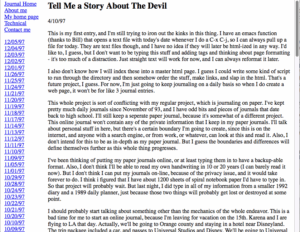Donald Cried is a film in the “you can never go back” camp, but it’s also more about the estranged relationship between two friends who were inseparable as teenagers, but took completely different paths into adulthood.
Originally a short by independent filmmaker Kris Avedisian, this was expanded to a feature-length affair with the help of a successful Kickstarter campaign. The film starts with the protagonist Peter returning to his home town in Rhode Island to handle the affairs of his recently deceased grandmother. He left the small town a dozen years before, and went to New York City to reinvent himself, forget his past, and work on Wall Street. The problem with his quick overnight trip: he’s lost his wallet, so he’s stuck at his grandmother’s old house with no cash, no ID, and a to-do list of funeral home, nursing home, realtor, and everything else involved in closing the last of his involvement with his old life.
With no other options, he turns to his last lifeline, and meets up with his old pal Donald, who he hasn’t seen since high school. Donald is a stoner dropout who lives in his mom’s attic, works part-time at a bowling alley, and is the opposite of Peter, stuck at the same point he was back in the glory days of high school. We quickly find out that Peter was once cut from the same cloth, and had the same love of heavy metal and juvenile delinquency. Peter just needs a ride to pick up his grandma’s ashes and empty out her nursing home, plus a few bucks for bus fare back to the city. Donald is ecstatic about the triumphant return of his old friend. Antics ensue.
I always have a certain nervousness when returning back to Indiana, and that’s captured too well in this film. It’s a mixture of “this could have been me” and flashbacks of the past that bring out the “man, I was an idiot back then.” My nostalgia issues are a bit contrary to Peter’s in the film, though. He’s trying to remain unseen, and not get entangled in the past. For example, the realtor he gets is a woman he went to school with, and that he had some feelings for back in the day, but he initially acts as if he doesn’t remember who she is at all. I’m not saying I seek out people and reunite with them (I did have an ex-girlfriend sighting at a mall a few years ago, and I ducked in another store to escape) but I do seem to seek out old landmarks and get too mentally involved with the ghosts of the past.
The real star of this movie is Avedisian, who plays the character of Donald. He’s this lanky, bearded guy with an awkward Ray Romano-sounding voice and a Keith Moon haircut, and he’s completely cringe-worthy in his total lack of a filter. This starts as a truly hilarious character, like a Mark Borchardt from American Movie, except with no ambition to make films. At first, he’s just the funny guy to the straight guy, but then you become sympathetic to him, feel sorry for him. My feelings bounced between “wow, what is with this dude” to “wow, how could Peter help this dude get his shit together.” And the latter is a strong one for my personal experience, so it really got me.
The small town setting was also big for me. Warwick isn’t a “small” town — it’s the second-biggest city in Rhode Island. But, it’s only 80,000 people, and what is captured in the film is the small town feeling of cruising at night, bowling alleys and convenience stores, little houses, and that feeling that a lot of people never leave, never forget high school, never move on. The duo go, on Donald’s insistence, to visit another one of their high school buddies. When they get there, he’s sitting in bed, unmoving, watching cage fighting matches on TV, like he’s never left the house in fifteen years. Or there’s the bowling alley manager, a burly guy actually played by former WWF wrestler Ted Arcidi, who’s in his office showing a teenaged cashier his grainy VHS tapes of when he used to be a powerlifter back in the Eighties and could bench 700 pounds. It’s an interesting backdrop, and really sets up why Peter left, and why it is such a strange yet compelling place to visit.
Overall, I have only one big problem with this film: I wanted to write a book that was almost exactly this. I started outlining it two years ago, when I went back to Indiana for a weekend. I had the backdrop, and I thought I had the characters. But I never could quite break the story correctly. And Avedisian showed me that I really didn’t have the depth needed to get the characters down. I gave up on the idea a while ago, and now I’m stuck on the thought that I really should do something with it, but of course if I started working on it, I’d unconsciously ape exactly what he did.
Anyway, it’s on iTunes for rent right now. Not for everyone, but I found it pretty entertaining.

